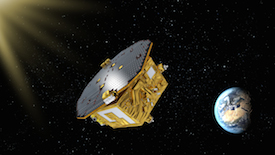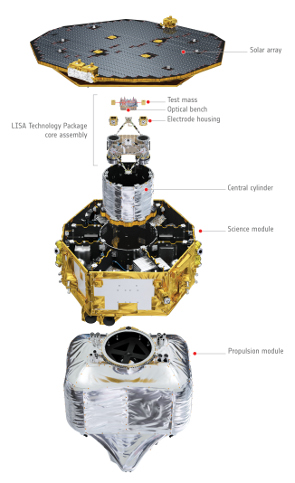A challenging build
 |
| Artistic view of LISA Pathfinder in space. Credit: ESA–C.Carreau |
Sunlight carries enough energy to push the object around in the frictionless environment of space. This is known as radiation pressure and spacecraft navigators have been aware of its effects since the early days of the space era. It would easily prevent a test mass from following the precise path that gravity dictates.
So to protect the object from the radiation pressure and other effects, engineers have no option but to build a spacecraft around it. This spacecraft will also contain all the equipment necessary to measure the movement of the test mass.
The trouble is, the spacecraft itself will generate forces capable of moving the test mass. These could be magnetic or electric forces, or indeed the gravitational field created by the spacecraft itself. It seems like catch-22 but that is where LISA Pathfinder comes in.
The mission holds two test masses and was designed to show that a spacecraft can be built to isolate such objects from all other forces except gravity. To do this, painstaking considerations must be taken into account.
 |
| Exploded view of the LISA Pathfinder spacecraft. Credit: ESA/ATG medialab |
Firstly, no magnetic material were planned to be used in the spacecraft. In the event, the lasers and thrusters needed some very small magnets to be used but these were positioned on the outer wall of the spacecraft, as far from the test masses as possible. Then, the test masses themselves were made of a special combination of gold and platinum. The metals were chosen and combined in such a way that the magnetic susceptibility of the finished alloy was virtually zero.
Secondly, the spacecraft has had to be balanced so that it does not pull on the test masses with its own gravitational field. This is what makes the construction of LISA Pathfinder one of the most ambitious space projects ever attempted. Everything that was fitted to the spacecraft had to have its mass and position accurately recorded.
A component on the outside of the spacecraft, about a metre away from the test masses, had to have its position measured to within a millimetre. Something placed close to the test masses, had to be placed to within a few tens of millionths of a metre.
Just moving a wire a few millimetres to one side could throw the spacecraft out of balance because of the mass of copper in the cable. The engineers building the spacecraft had to keep unprecedentedly meticulous records of everything that went on or came off the spacecraft. The mass logs run to hundreds of pages.
At the end of the build, a final compensating mass was placed near the test mass. Then smaller, fine-tuning masses were applied near the outside of the spacecraft as needed. According to the computer model of the spacecraft’s gravitational field, based on the mass logs kept by the engineers, LISA Pathfinder will generate an internal gravitational force, at the position of the test masses, of just one tenth of a billionth of Earth’s gravity.
But this cannot be verified on Earth. Only by sending LISA Pathfinder into a free fall environment, can the success of the engineering be tested. It is for this reason, that the mission had to be launched into space. We have to test if we can actually build spacecraft capable of protecting test masses from everything except the natural pull of gravity.
